(This article is modified from one published in issue 537 of this newsletter written by Sarah E. Hulick and Steve Reiners, Department of Horticulture Science, Cornell University, NYSAES. Liz Maynard also contributed to this article.)
Recent storms have brought hail to parts of Indiana. Loss of yield and quality in vegetable crops due to hail depends on the crop, stage of growth, amount of injury, and future growing conditions.
Disease control is absolutely essential after hail damage. Surviving plants will also benefit from a sidedressing of nitrogen about a week after the damage occurred. The following is a summary of all the information we could find relating to hail and vegetable recovery.
Bell Peppers. A study was conducted in North Carolina to determine the impact of hail on the incidence of bacterial spot. The hailstorm occurred 38 days after transplanting when the plants were still young and recovery was possible. Researchers found that a copper plus maneb spray program helped suppress bacterial spot and induce recovery of a young pepper crop from hail damage. Damage from a hailstorm increases plants’ susceptibility to pathogens immensely. Prior to the hailstorm, 53% of unsprayed plants and 13% of weekly and bi-weekly sprayed plants showed symptoms of bacterial spot. After the hail damage all plants showed disease. In unsprayed plots, the combination of hail and early Bacterial spot caused a 6-fold reduction in yield. In sprayed plots the reduction in yield was only 2-fold.
In a jalapeno pepper trial at Pinney-Purdue a few years ago, many of the plants had the main stem broken by hail. Yields from plants with broken stems were about 72% of the yield from plants with undamaged stems.
Tomatoes. Direct damage to fruit can make fruit unmarketable and open fruit up to secondary pathogens. It is best to remove all damaged fruit as keeping unmarketable fruit on the vine wastes the plant’s resources. If plant damage is mostly defoliation with some broken stems, recovery can occur. This is especially true for large, indeterminate plants. Harvest may be delayed significantly as it takes about 40-50 days from flowering to ripe fruit. Growers may want to invest in floating row covers to protect the later fruit from an early frost in the fall.
Melons and other vine crops. Defoliation has the greatest negative impact on marketable yield when it occurs just before the canopy covers all bare ground on the plots, or approximately 30-40 days before first harvest. Defoliation decreases the fruit soluble solids concentration, which can make the melons less flavorful. Muskmelons and watermelons have the ability to fully recover from defoliating hail damage if it occurs early in the season (especially during fast vegetative growth stage) and if the growing season is long enough. Defoliation causes fruit exposure to the sun, sunscalds and premature ripening. All vine crops have some capacity to compensate for lost leaf area if it happens before vegetative growth slows. Figures 1 to 3 show recent hail damage on pumpkins.
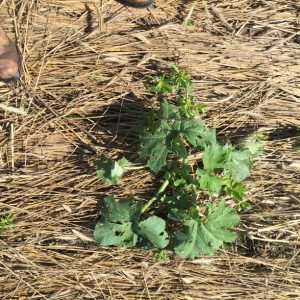
Figure 1. Hail has tattered leaves on this bush-stage pumpkin plant growing in a roller-crimped rye cover crop.
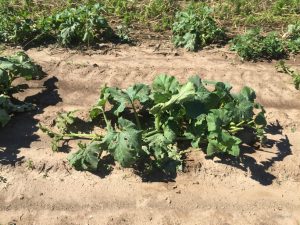
Figure 2. Hail has punched holes in leaves, broken petioles, and bruised the stem of this pumpkin plant that is beginning to vine. Photos taken 7/13/2020. Hail 7/12/2020. Pinney Purdue Ag Center, Wanatah, IN.
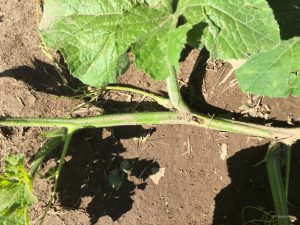
Figure 3. The stem of this pumpkin has been damaged by hail just below the node where a female flower bud is visible. Buds at this stage sometimes abort in stressful conditions. If I can find it later I will check back and see whether it develops or not.
Sweet Corn. In a variety trial hit by hail, sweet corn was at the tasseling stage and suffered shredded leaves. Total yields were reduced by 57% compared to the prior 3-year average. Sweet corn at the 12-18 inch stage experienced the same hail and yields were reduced 42 % compared to the 3-year average. In a trial conducted in Delaware, all hail treatments reduced the percentage of marketable ears of sweet corn, except for the light application in the 13th leaf stage (early vegetative) in 1991. In 1992, additional treatments consisting of clipping all leaves were conducted. Clipping leaves at the early silking stage reduced marketable ears, indicating the loss of foliage adversely affected the growth of the ear. Clipping leaves just prior to harvest reduced the yield of Jubilee, but not Silver Queen. Figures 5 and 6 show recent hail damage on sweet corn.
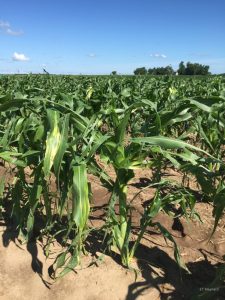
Figure 5. Sweet corn at about the 6-7 leaf collar stage that has been damaged by hail. (The bleached leaf areas are a response to an earlier herbicide application.)
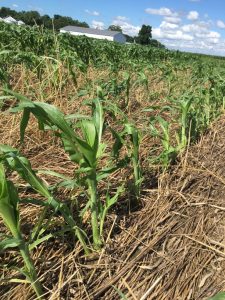
Figure 6. Hail injury on sweet corn at about the 4-5 collar stage, planted into a rolled rye cover crop. Shredded leaves and bruised leaf sheaths are visible.
Onions. Defoliation has the greatest impact on total marketable yield and yield of individual market classes when it occurs near the onset of bulbing. The greatest effect the hail damage inflicts on onions is the market class distribution. Jumbos (>3.25”) decrease in number and the medium and prepack size distribution increases. Yields of the larger marketable class decrease to a greater extent than the total marketable yield. In a study conducted in Colorado a 67% defoliation at 14,18, 42,and 56 days before maturity caused a 10%, 52%, 63%, and 51% decrease respectably in jumbo yields. A 33% plant defoliation on the same dates resulted in a 15%, 21%, 17%, and 24% reduction in Jumbo class yields. The medium class makes up for these decreases by increasing in number. Defoliation can delay crop maturity and makes onions more susceptible to disease infection.
Cauliflower. Damage done before budding does not significantly affect the budding process. Later defoliation tends to change the color of the cauliflower heads from white or ivory to a yellowish-white. The yellowing is more pronounced the greater the defoliation and the later the stage at which defoliation occurs. In plants in which the stems
get bent back, the heads can be elongated and in some cases deformed. Defects: sunburn, frost damage, warts, and attack by slugs and snails are more frequent in plants with greater defoliation and/or later in the season. Most importantly, defoliation at later stages is going to have a greater adverse effect on number and mass of heads than defoliation at earlier stages. The greatest mass lost from hail damage will occur when heads are between 2-3.8 cm.
Soybeans. We could not find any studies on snap beans but in this Oregon soybean study, 80% defoliation on plants with substantial stem breakage, 5 weeks after planting resulted in a 40% reduction in yield. Plants grew back, but not to full stature.